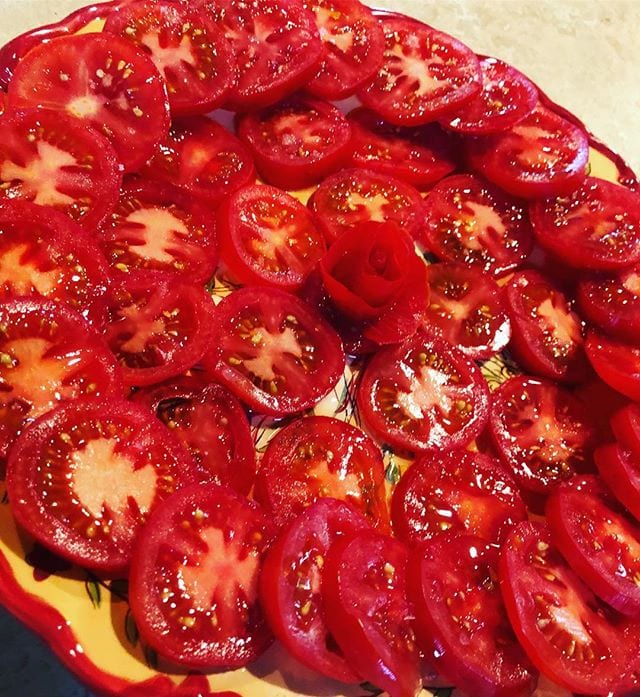Tomatoes are beautiful creatures. There is nothing like the perfect combination of acidity and texture that you find in a fresh-from-the-garden, home-grown tomato. I once heard that if you can’t grow tomatoes in your garden then there is no reason to have a garden. I agree with that.
In the summertime my favorite “recipe” for fresh tomatoes is to serve them simply sliced medium thickness, layered on a platter, and sprinkled with fleur de sel right before service.

If you find your self later in the season and want to freshen up your tomatoes for service, then blanch and peel them. Peeled tomatoes is a southern tradition and was just about the only way my baby sitter served them to me growing up. You almost never see peeled tomatoes anymore but a beautiful salad or first course is to peel a couple of pounds of cherry tomatoes, toss them with some kosher salt, and serve them in a bowl. Amazing.

If you can’t buy fresh, in-season tomatoes for a recipe then make sure you find a good canned variety. I prefer San Marzano tomatoes and always buy them whole. They use the best, highest graded tomatoes for the whole version and use the lesser quality ones for the diced or crushed cans. But, the best possible canned tomato is one you do yourself.
Naturally acidic, tomatoes lend themselves to be canned at home and are especially easy and safe if you follow a few basic instructions. First and foremost, buy fresh tasty tomatoes. If they aren’t worth eating fresh now, then they won’t be worth eating out of a can. In other words, canning won’t improve their flavor. Next, be clean and accurate when you pack the jars and follow the rules. I use a rather simple method that Sean Brock of Husk uses for my canned tomatoes but it does require a bit of science. If you don’t have the tools or if you just want to follow a recipe and not worry, then I’ve included those instructions as well.
In general you will need 3 lbs. of fresh tomatoes for each quart jar. So in this recipe for 4 quarts of tomatoes, start with 12 lbs.
12 lbs fresh from the garden tomatoes
4 tbs lemon juice, fresh, approximate
4 tsp kosher salt
Clean and blanch tomatoes and then peel their skins off with a paring knife. I leave the core intact which preserves the shape and integrity of the fruit. Place the tomatoes in a large saucepan with their juice and salt. Measure the pH (see note). Add lemon juice to the tomatoes until the pH measures at least 4.6 or lower. Once you have corrected the pH, heat the mixture on the stove until the internal temperature of the tomatoes reads 180 degrees Fahrenheit. Then spoon the tomatoes and juice into sterilized quart jars leaving 1/2 inch of head space at the top. Place a new lid on the jar and gently tighten the lid. Place the jars upside down on a tea towel and allow to cool. The lids should be firmly attached when the bands are removed. If they aren’t, process as outlined below.
Alternative method: After peeling the tomatoes, pack them into sterilized jars leaving 1/2 inch of headspace at the top. Add 1 Tbs of lemon juice and and 1 tsp of kosher salt to each jar. Place on a new lid and gently tighten with a band. Place the jars on a wire rack in a large pot of water that completely covers the jars. Process with boiling water for 45 minutes and then remove the jars. Sit them on a tea towel and allow them to completely cool.

Note: Measuring pH sounds hard but it only requires a simple pH meter obtained online. Be sure to find one that can be easily calibrated. Measuring the temperature of the tomatoes is equally important and for this plus many recipes in this blog you will need a good instant read thermometer. I recommend the Thermapen.
#tomatoes #canning

